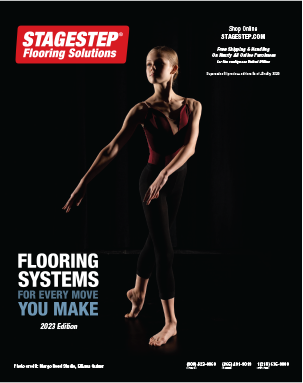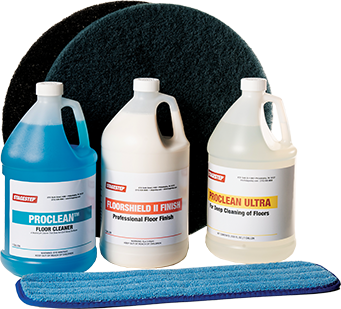In the dance industry, the term “marley” describes just about any roll-out vinyl floor used as a dance floor. The moniker turns out to be a bit confusing, since it could mean any number of very different dance floors used for a variety of purposes. So, where does the name come from? And what is it?
Where Did the Name “Marley” Come From?
Though the term “marley” gets used widely, dance vinyl flooring takes its name from the company that started producing it — the Marley Company.
The Marley Company
Back in the 1960s, the Marley Company in England made many vinyl floor, wall and roof products. They developed a thin reversible vinyl black/gray flexible floor called “Stageflor.”
The story goes that an executive’s daughter was a professional dancer who complained to her father about all the different theater stage surfaces she had to dance on while on tour. He came up with Stageflor. Urban legend or truth — it doesn’t matter. The Marley Company made each floor to order, and the customer had to handle the paperwork, shipping and duty. It took five months to get a floor back in those days.
Stagestep Takes Over
Here in the U.S., Stagestep began handling the paperwork and logistics for bringing Stageflor into the country. Soon after, Stagestep brought in full rolls and started custom cutting dance floors in America.
By the mid-1970s, you only had to wait a month to get your floor. The choice of colors increased, so you could get:
- Black and gray
- Black and white
- Black and tan reversible
Of course, now you can get a wide array of colors or patterns that mimic wood or marble.
In 1979, the Marley Company stopped making Stageflor. Over the years, the original company changed hands several times and virtually disappeared. By the time Marley shut down the production of Stageflor, Stagestep had introduced a variety of different types of flooring, which we’ll talk about in the next section.
Stagestep first brought the idea of the reversible floor to manufacturing plants in the U.S., but when they closed their doors, the company moved the operation to Europe.
What Is Marley?
While Marley is a registered trademark, in dance, marley refers to any roll-out vinyl dance floor. They can have multiple layers and are specifically for the needs of different types of dance.
Types of Marley Flooring
If you’re buying a dance floor, you can’t only say you need a “marley” floor, because that term encompasses so many different products and types of flooring. They’ll work for different styles of dance and typically pair with a floating wood subfloor and surface treatments.
Our marley flooring options include the following.
- Timestep dance floors: Timestep is the most versatile option, with a heavy-duty surface for everything from ballet and ballroom dance to tap and flamenco. You can roll it up for portable use or install it permanently. We even have a thinner and lighter option for touring and temporary applications.
- Bravo dance floors: Our Bravo floors offer exceptional durability without sacrificing portability — although it is just as well-suited for permanent installations. Our Bravo floors are reversible and its fiberglass lining helps improve stability and lie-flat qualities.
- Dancestep Plus dance floors: For installations directly on concrete, Dancestep is the way to go. You can also install it on stages and hardwood surfaces for portable or permanent use. Dancestep has a dual density cushioning layer to help absorb energy and reduce sound. Due to this, it is suitable for all dance styles except tap.
- Rave dance floors: For bright floors that pop, the lightweight and economical Rave dance floor is always an excellent choice. It has a thin foam backing and is perfect for ballet, jazz and contemporary dance, though any dance style besides tap will work well.
- Shaw 10 dance floor: Perfect for the stage and the studio, our Shaw 10 Marley floor is an extra wide 10-foot portable option ideal for contemporary, jazz, pallet and more. Our Shaw 10 floor also features free shipping in the US!
- Quietstep dance floors: Quietstep is a foam-backed, non-slip floor that is excellent for ballet. It offers superior lie-flat qualities with the help of its fiberglass lining.
- Woodstep dance floor: Finally, our Woodstep flooring combines a realistic wood look with the low-maintenance, portable qualities of marley vinyl.
How to Use Marley Flooring
Many kinds of marley flooring feature portable design, so you can take them with you to various performance locations, but others are perfect for permanent installations. In either case, they often work alongside a subfloor system, though it’s possible to install many directly on concrete or hardwood.
Subfloors create shock-absorbing surfaces that go underneath the marley and support different types of dance with shock absorption and resilience. We have floating wood subfloors with varying constructions that offer the right kind of shock absorbancy.
Our dance floors are fabricated for easy installation, and Stagestep offers a variety of options to help you with the installation process.
The Popularity of Marley Floors
Marly dance floors started on the stage, but these roll-out vinyl floors and flooring systems soon migrated to the studio. Why rehearse on a wood surface when you perform on a marley floor in the theater? The name “marley” stuck, so that is why we have the generic name used to describe many products manufactured to various specs and used for a wide range of purposes.
For dance companies and school facilities directors looking for a new floor, it is essential to be more specific than asking for a marley dance floor. Drill down to the specific name of the floor and find out its specs and uses. Some floors are great for tap, others not at all, some are for ballet, some are for touring and others are multipurpose — ideal for a studio.
Remember, there is no such thing as a marley dance floor — except for every roll-out dance floor on the planet!



